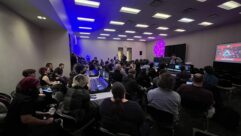Vanishing Act
Apr 1, 1998 12:00 PM,
Gregory A. DeTogne
To be heard and not seen was the audio system design edict issued at theoutset of construction of the Bistro Roxy, a Parisian-style restaurantfound in downtown Reno, NV, Eldorado Hotel and Casino. Carried out to theletter for a $5 million ambience-rich dining experience, this request foraudio invisibility forced system designers to face a paradox. Building asystem with the high-performance qualities necessary to provide soundreinforcement for the Bistro Roxy’s programmed and live input sourcesseemed diametrically opposed to eliminating visible evidence of the system,including the loudspeakers.
Opened in December 1997, the Bistro Roxy lies on the Eldorado’s mezzaninelevel. With restaurant seating for 175 with 50 more in a bar and loungearea, the upscale restaurant borders the hotel and casino’s 20-piece,flamboyantly rococo Fountain of Fortune, a baroque monument crafted frommarble and bronze. Seven different architectural spaces define the BistroRoxy, all of which combine to impart its distinctly European verve. Theauthenticity of this rich atmosphere is drawn from construction materialsimported from the continent itself. Ceiling stones from Bosnia are joinedby cobblestones from Austria and French mosaic tiles to bring proper dosesof Old World charm.
Rising to meet the challenge of performing the audio system vanishing actrequired of the space were members of the Eldorado’s own A-V team,including current hotel and casino technical director Pete Costello.Joining Costello and crew was Reno-based Starsound Audio, a veteran pro-audio concern owned by Scott Bergstrom.
Both groups began the task in July 1997, with overall design, control,processing and amplification elements being drawn together by the in-houseEldorado team. That left Bergstrom and Starsound Audio scratching theirheads with the problem of locating loudspeakers that could be made todisappear completely within the walls and ceiling. Even extremely compactloudspeaker enclosures or anything else maintaining a visible presence ofany sort were deemed unacceptable.
“Given that the usual methods weren’t acceptable, it was only natural thatwe go totally alternative,” Bergstrom recalled. “There was no way to dothis with a conventional loudspeaker, so I didn’t try.”
Instead, he opted for planar loudspeaker technology as delivered by SA2loudspeakers from Sound Advance Systems, which are flat-panel, or planar,in design. Made of a styrofoam-like composite material measuring only 3inches (74 mm) deep, they use the walls or ceilings in which they areplaced as part of their radiating surface to provide audiophile performancein wide, evenly dispersed patterns. Further, they can be painted orwallpapered over and are also equipped with protective circuitry as asafeguard against mechanical or thermal overload. Special crossovernetworks split audio signals between each unit’s low- and high-frequencysection at 1 kHz, while overall frequency response lies between 70 Hz and20 kHz, and maximum power handling is rated at 120 W program. If an SA2fails after becoming part of the infrastructure, the manufacturer’sguarantee provides for replacement of the loudspeaker and the wall. Therewas, however, little documentation at hand pertaining to anyone who haddealt with brick or stone surfaces. Undaunted, Bergstrom took delivery of aB-stock SA2 sans drivers, and began experimenting with various faux brickand stone treatments.
To create the first prototype brick and stone SA2 coverings, he rough-cutstyrofoam blocks on a table saw. Next, using examples of the Bistro Roxy’sactual brick and stone as models, he flailed away with a hacksaw blade andwhittled the faux proportions down to proper dimensions of height and finedetail complete with the right amounts of pitting and other irregularities.Paints and dyes gathered from a variety of sources were mixed to provideproper colors, with plaster of Paris and actual brick powder added asrequired.
Initially, applying the paints and dyes to the faux brick and stone wasthought to be a job best left to an airbrush, but as it turned out, spraycans of the same colors mixed proportionately were just as effective. Aftertwo days, Bergstrom emerged at the Eldorado with completed fauxbrick-and-stone models for review. All concerned examined his efforts, thengave the designs a green light to proceed to final refinement.
During this last phase, one of the most difficult problems encountered wasrecreating the grout used between the bricks and stones. When morededicated experimentation revealed that the Sound Advance masking materialused to attach the faux bricks and stones to the front panels of the SA2sserved in this capacity equally well, the path was cleared forinstallation. In total, a dozen of Sound Advance’s SA2s were concealedthroughout the Bistro Roxy, the majority of which received faux brick orstone treatments.
“There was a learning curve on the front end of this whole installationprocess just like anything else,” Bergstrom said humbly. “But once we gotrolling, things fell into place.”
With Eldorado personnel hanging the loudspeakers and pulling the wire, pluslending a hand to the faux brick and stone concealment process, the audioinstallation relied on Bergstrom’s SA2s for sound reinforcement in mostareas throughout the restaurant. Exceptions included the wine cellar, wherea domed ceiling bordered by an overhanging ledge allowed the installationteam to stash JBL’s minuscule Control 1 Plus loudspeakers out of sight inan area between the ledge and the beginning of the dome’s rise. Tofacilitate live performances in the terrace dining area, which are alsoheard in an “outdoor” seating area within close proximity of the Fountainof Fortune, SA2s are supplemented by two pre-existing SA2s facing thefountain, as wellas a contingent of EAW enclosures consisting of JF/80s,JF/60s and subwoofers. Processing and control elements, as well as systemamplification, are all housed out of sight in a pair of WRK rack enclosuresfrom Middle Atlantic Products located in an equipment room on the levelabove the Bistro Roxy. Selected on the basis of the sizable interior spacethey provide in relation to the small footprint they leave, the WRKs wereleft doorless both front and back as an inexpensive aid to cooling.Available power includes a pair of Rane MA 6S amps that each supply sixmonaural channels of 150 W each at 8 V to the system-wide SA2s. Installedexpressly for the EAW JF Series loudspeakers, three Crown Power-Tech 2 ampsreside in the second of the two racks above a spare Power-Tech 2 and aCrown MA-600 which serves the EAW subwoofers. A MediaMatrix Miniframe fromPeavey, aided by the controlling guidance of an AMX AXCESS system, can bestbe described as the brains behind the operation. Assisted by a singlebreak-out box, the MediaMatrix Miniframe is used to insure that inputsignals are routed to the right place at the right time, as well as for avariety of processing and virtually all mixing functions.
“The MediaMatrix Miniframe was the perfect choice for this application,”Eldorado technical director Pete Costello said. “With eight inputs andeight outputs, it was ideally suited for the eight distinct audio zonescomprising this environment. Of these eight zones, one is mapped out foreach of the seven restaurant areas. The eighth is for those seated outsideby the fountain.”
Inside the MediaMatrix Miniframe are eight parametric EQ sections that havebeen delegated at a rate of one apiece for each of the eight zones. Withonboard compression also available in the Miniframe plus automatic gaincontrol and an eight-bus mixer, adjustments to MediaMatrix systemparameters are all made via two on-screen windows.
On the control end, the AMX AXCESS system is used to adjust gain, input, orany of the bus features on each channel of the MediaMatrix mixer via ahandheld RF/IR keypad. Operating in a controlling capacity only, the AMXAXCESS system communicates with the MediaMatrix via code through a standardRS-232 port. Outside of live performance situations, which generallyfeature a piano player or vocalists using a Shure UHF wireless system,input is supplied via sources including a CD player and a pair of90-channel DMX digital audio receivers. Under normal circumstances, a”restaurant mode” is selected where light music is sent to all seven zonesresiding within the Bistro Roxy’s walls. When the piano player or otherlive performers arrive, that music is muted in the terrace dining areawhere they perform, and the live program material is brought up. BistroRoxy management has also experimented with other source material, such aslate-night disco.
“Besides meeting the criteria for remaining unseen in all respects, thesystem does indeed offer us the performance and flexibility we set out toobtain,” Costello added. “We achieved a degree of control which frees usfrom running back and forth to the control room to make adjustments withoutspending a fortune, and the loudspeakers provide clean articulation andfidelity. It may have been a challenge to put this all together like wedid, but what more could you ask from this type of system?”










